Corporate Governance and Ethics Report for ABC International Ltd
VerifiedAdded on 2023/01/13
|15
|3764
|1
Report
AI Summary
This report provides a comprehensive analysis of corporate governance and ethics, addressing key aspects relevant to ABC International Ltd. It begins by examining the duties, rights, and competences of directors, referencing legal requirements and case law to define their responsibilities. The report then delves into committee work, specifically focusing on the audit committee's tasks, including financial processes, audit oversight, and interaction with external auditors. Furthermore, the report explores board structure and styles, considering board diversity, executive versus non-executive director roles, and the application of one-tier board structures. Finally, it addresses transparency and accountability, covering compliance with listing requirements, shareholder reporting, and the importance of trust among board members. The report aims to offer professional advice regarding matters of corporate governance, providing a detailed overview of the company's practices and recommendations for improvement.
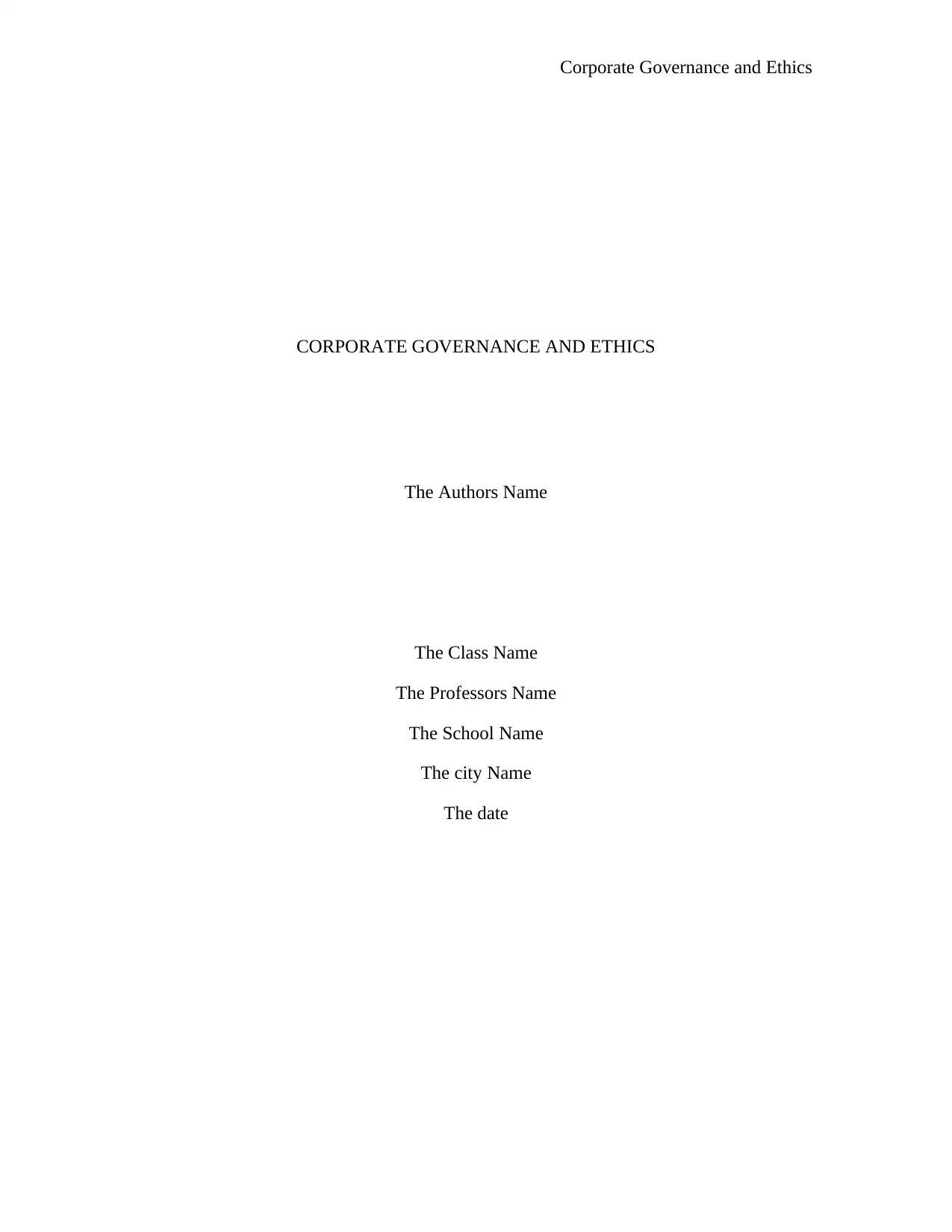
Corporate Governance and Ethics
CORPORATE GOVERNANCE AND ETHICS
The Authors Name
The Class Name
The Professors Name
The School Name
The city Name
The date
CORPORATE GOVERNANCE AND ETHICS
The Authors Name
The Class Name
The Professors Name
The School Name
The city Name
The date
Paraphrase This Document
Need a fresh take? Get an instant paraphrase of this document with our AI Paraphraser
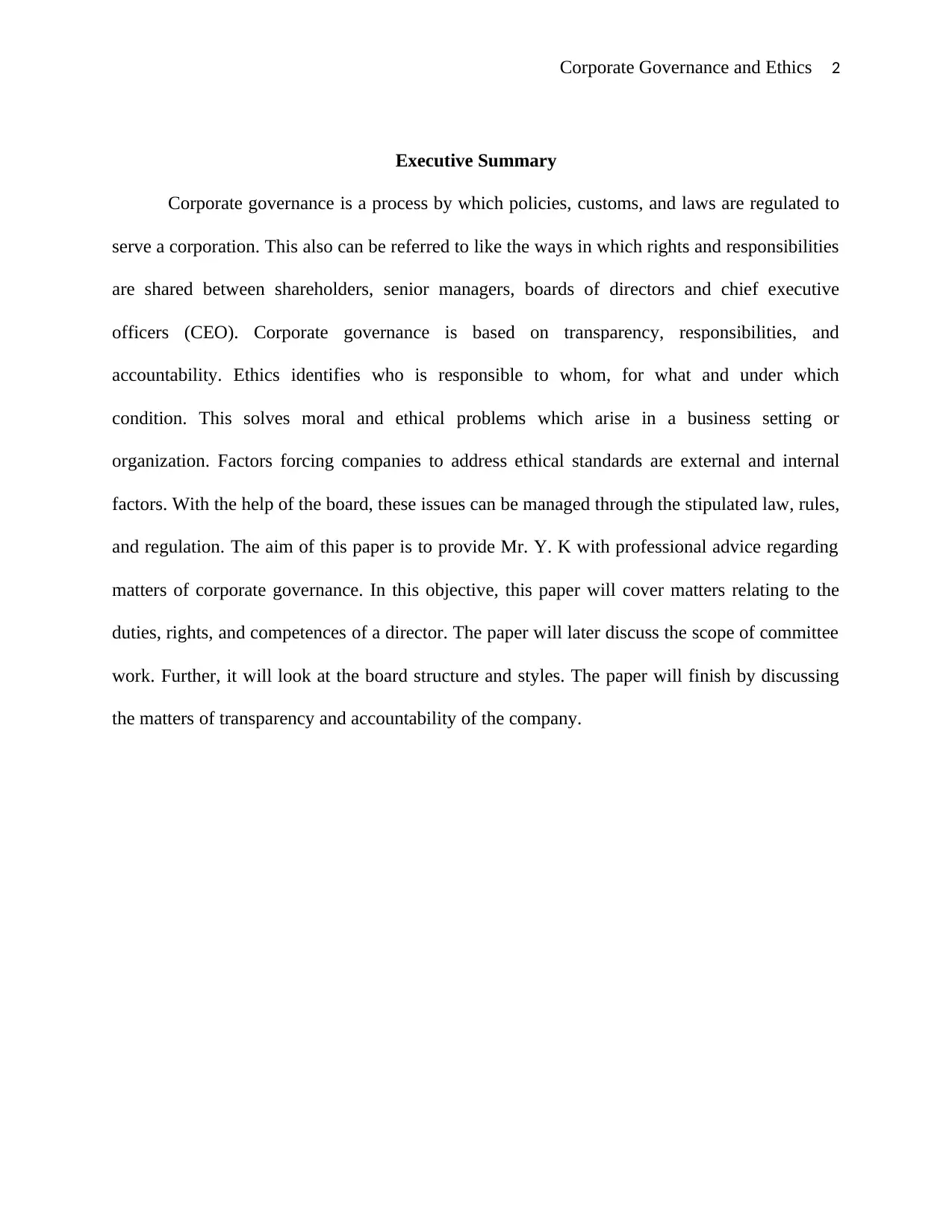
Corporate Governance and Ethics 2
Executive Summary
Corporate governance is a process by which policies, customs, and laws are regulated to
serve a corporation. This also can be referred to like the ways in which rights and responsibilities
are shared between shareholders, senior managers, boards of directors and chief executive
officers (CEO). Corporate governance is based on transparency, responsibilities, and
accountability. Ethics identifies who is responsible to whom, for what and under which
condition. This solves moral and ethical problems which arise in a business setting or
organization. Factors forcing companies to address ethical standards are external and internal
factors. With the help of the board, these issues can be managed through the stipulated law, rules,
and regulation. The aim of this paper is to provide Mr. Y. K with professional advice regarding
matters of corporate governance. In this objective, this paper will cover matters relating to the
duties, rights, and competences of a director. The paper will later discuss the scope of committee
work. Further, it will look at the board structure and styles. The paper will finish by discussing
the matters of transparency and accountability of the company.
Executive Summary
Corporate governance is a process by which policies, customs, and laws are regulated to
serve a corporation. This also can be referred to like the ways in which rights and responsibilities
are shared between shareholders, senior managers, boards of directors and chief executive
officers (CEO). Corporate governance is based on transparency, responsibilities, and
accountability. Ethics identifies who is responsible to whom, for what and under which
condition. This solves moral and ethical problems which arise in a business setting or
organization. Factors forcing companies to address ethical standards are external and internal
factors. With the help of the board, these issues can be managed through the stipulated law, rules,
and regulation. The aim of this paper is to provide Mr. Y. K with professional advice regarding
matters of corporate governance. In this objective, this paper will cover matters relating to the
duties, rights, and competences of a director. The paper will later discuss the scope of committee
work. Further, it will look at the board structure and styles. The paper will finish by discussing
the matters of transparency and accountability of the company.
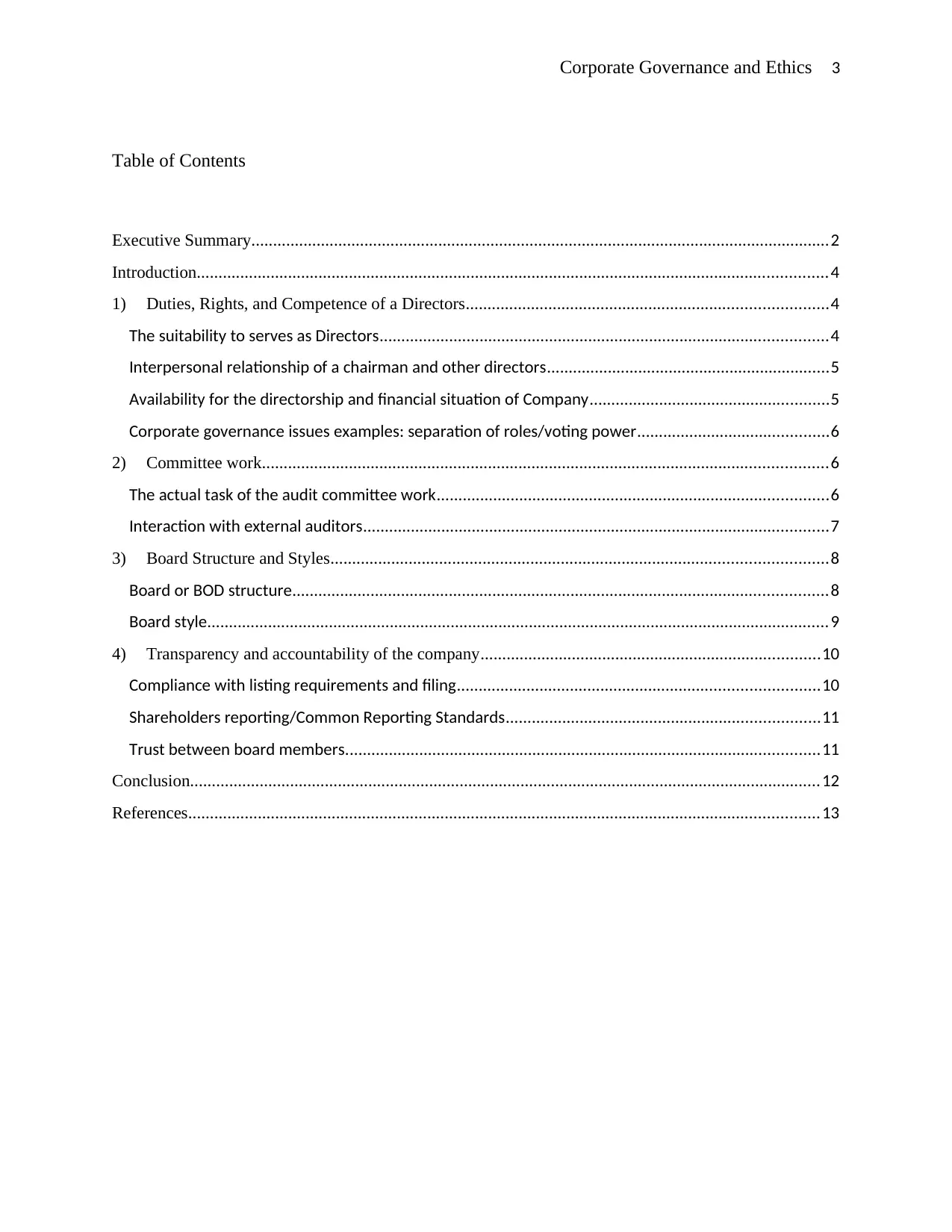
Corporate Governance and Ethics 3
Table of Contents
Executive Summary.....................................................................................................................................2
Introduction.................................................................................................................................................4
1) Duties, Rights, and Competence of a Directors...................................................................................4
The suitability to serves as Directors.......................................................................................................4
Interpersonal relationship of a chairman and other directors.................................................................5
Availability for the directorship and financial situation of Company.......................................................5
Corporate governance issues examples: separation of roles/voting power............................................6
2) Committee work..................................................................................................................................6
The actual task of the audit committee work..........................................................................................6
Interaction with external auditors...........................................................................................................7
3) Board Structure and Styles..................................................................................................................8
Board or BOD structure...........................................................................................................................8
Board style...............................................................................................................................................9
4) Transparency and accountability of the company..............................................................................10
Compliance with listing requirements and filing...................................................................................10
Shareholders reporting/Common Reporting Standards........................................................................11
Trust between board members.............................................................................................................11
Conclusion.................................................................................................................................................12
References.................................................................................................................................................13
Table of Contents
Executive Summary.....................................................................................................................................2
Introduction.................................................................................................................................................4
1) Duties, Rights, and Competence of a Directors...................................................................................4
The suitability to serves as Directors.......................................................................................................4
Interpersonal relationship of a chairman and other directors.................................................................5
Availability for the directorship and financial situation of Company.......................................................5
Corporate governance issues examples: separation of roles/voting power............................................6
2) Committee work..................................................................................................................................6
The actual task of the audit committee work..........................................................................................6
Interaction with external auditors...........................................................................................................7
3) Board Structure and Styles..................................................................................................................8
Board or BOD structure...........................................................................................................................8
Board style...............................................................................................................................................9
4) Transparency and accountability of the company..............................................................................10
Compliance with listing requirements and filing...................................................................................10
Shareholders reporting/Common Reporting Standards........................................................................11
Trust between board members.............................................................................................................11
Conclusion.................................................................................................................................................12
References.................................................................................................................................................13
⊘ This is a preview!⊘
Do you want full access?
Subscribe today to unlock all pages.

Trusted by 1+ million students worldwide

Corporate Governance and Ethics 4
Paraphrase This Document
Need a fresh take? Get an instant paraphrase of this document with our AI Paraphraser
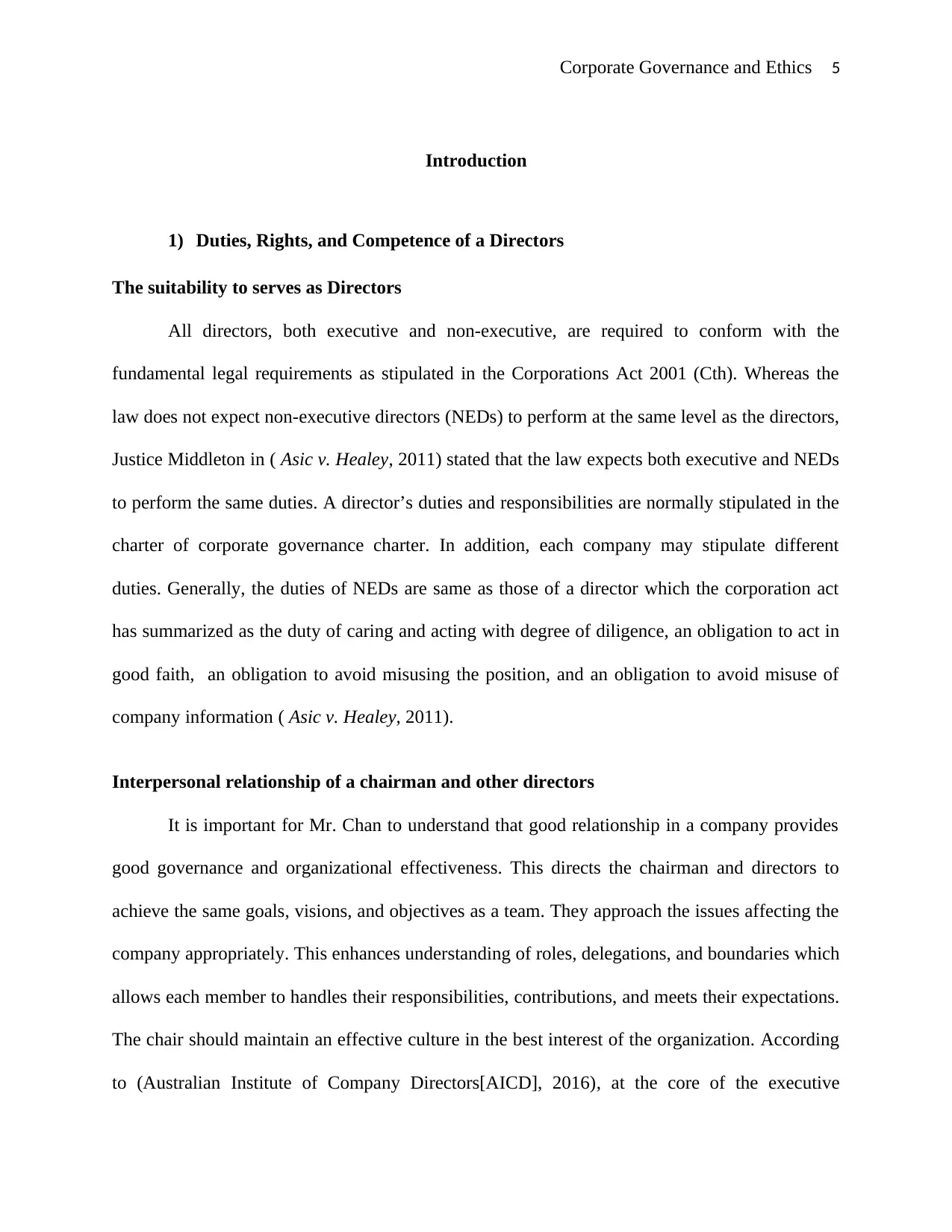
Corporate Governance and Ethics 5
Introduction
1) Duties, Rights, and Competence of a Directors
The suitability to serves as Directors
All directors, both executive and non-executive, are required to conform with the
fundamental legal requirements as stipulated in the Corporations Act 2001 (Cth). Whereas the
law does not expect non-executive directors (NEDs) to perform at the same level as the directors,
Justice Middleton in ( Asic v. Healey, 2011) stated that the law expects both executive and NEDs
to perform the same duties. A director’s duties and responsibilities are normally stipulated in the
charter of corporate governance charter. In addition, each company may stipulate different
duties. Generally, the duties of NEDs are same as those of a director which the corporation act
has summarized as the duty of caring and acting with degree of diligence, an obligation to act in
good faith, an obligation to avoid misusing the position, and an obligation to avoid misuse of
company information ( Asic v. Healey, 2011).
Interpersonal relationship of a chairman and other directors
It is important for Mr. Chan to understand that good relationship in a company provides
good governance and organizational effectiveness. This directs the chairman and directors to
achieve the same goals, visions, and objectives as a team. They approach the issues affecting the
company appropriately. This enhances understanding of roles, delegations, and boundaries which
allows each member to handles their responsibilities, contributions, and meets their expectations.
The chair should maintain an effective culture in the best interest of the organization. According
to (Australian Institute of Company Directors[AICD], 2016), at the core of the executive
Introduction
1) Duties, Rights, and Competence of a Directors
The suitability to serves as Directors
All directors, both executive and non-executive, are required to conform with the
fundamental legal requirements as stipulated in the Corporations Act 2001 (Cth). Whereas the
law does not expect non-executive directors (NEDs) to perform at the same level as the directors,
Justice Middleton in ( Asic v. Healey, 2011) stated that the law expects both executive and NEDs
to perform the same duties. A director’s duties and responsibilities are normally stipulated in the
charter of corporate governance charter. In addition, each company may stipulate different
duties. Generally, the duties of NEDs are same as those of a director which the corporation act
has summarized as the duty of caring and acting with degree of diligence, an obligation to act in
good faith, an obligation to avoid misusing the position, and an obligation to avoid misuse of
company information ( Asic v. Healey, 2011).
Interpersonal relationship of a chairman and other directors
It is important for Mr. Chan to understand that good relationship in a company provides
good governance and organizational effectiveness. This directs the chairman and directors to
achieve the same goals, visions, and objectives as a team. They approach the issues affecting the
company appropriately. This enhances understanding of roles, delegations, and boundaries which
allows each member to handles their responsibilities, contributions, and meets their expectations.
The chair should maintain an effective culture in the best interest of the organization. According
to (Australian Institute of Company Directors[AICD], 2016), at the core of the executive
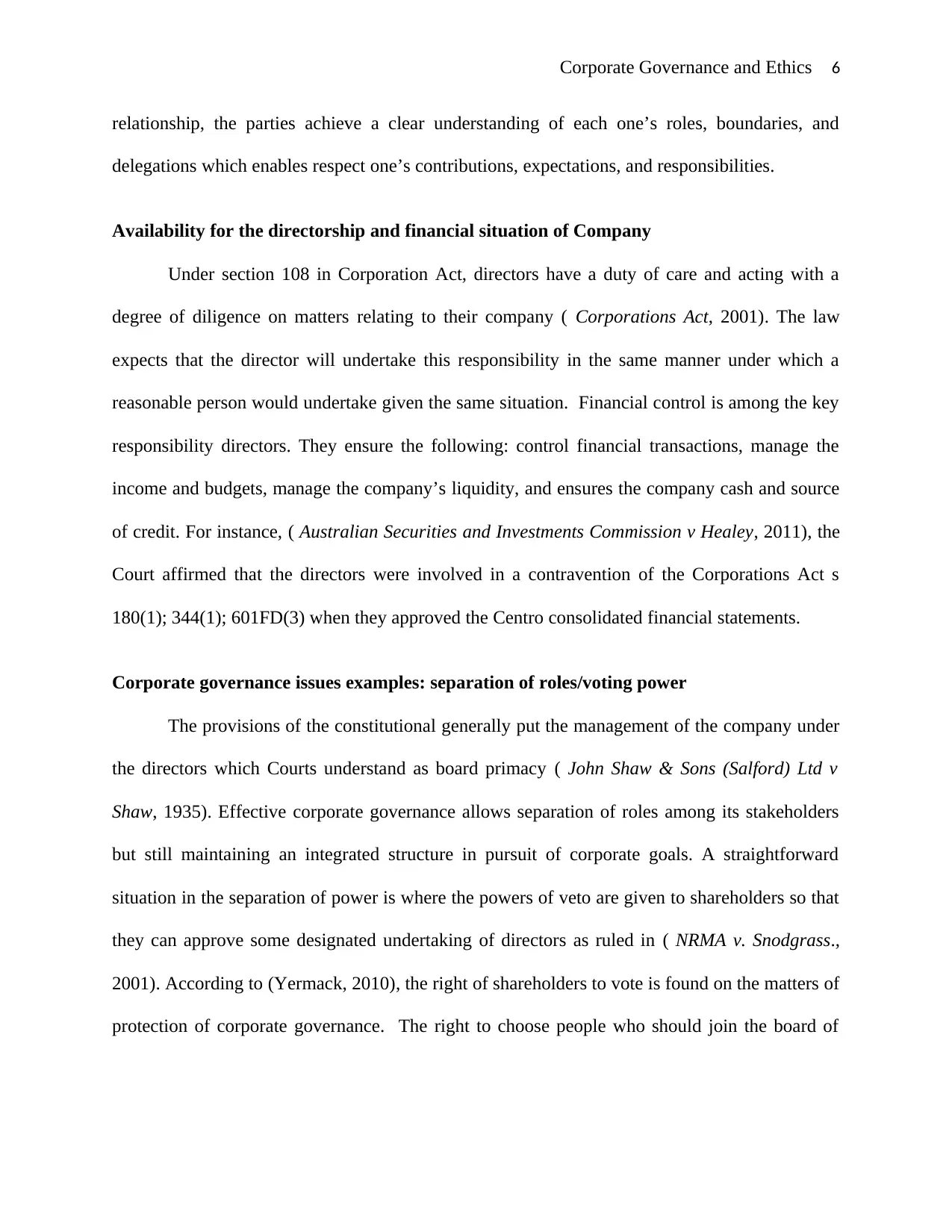
Corporate Governance and Ethics 6
relationship, the parties achieve a clear understanding of each one’s roles, boundaries, and
delegations which enables respect one’s contributions, expectations, and responsibilities.
Availability for the directorship and financial situation of Company
Under section 108 in Corporation Act, directors have a duty of care and acting with a
degree of diligence on matters relating to their company ( Corporations Act, 2001). The law
expects that the director will undertake this responsibility in the same manner under which a
reasonable person would undertake given the same situation. Financial control is among the key
responsibility directors. They ensure the following: control financial transactions, manage the
income and budgets, manage the company’s liquidity, and ensures the company cash and source
of credit. For instance, ( Australian Securities and Investments Commission v Healey, 2011), the
Court affirmed that the directors were involved in a contravention of the Corporations Act s
180(1); 344(1); 601FD(3) when they approved the Centro consolidated financial statements.
Corporate governance issues examples: separation of roles/voting power
The provisions of the constitutional generally put the management of the company under
the directors which Courts understand as board primacy ( John Shaw & Sons (Salford) Ltd v
Shaw, 1935). Effective corporate governance allows separation of roles among its stakeholders
but still maintaining an integrated structure in pursuit of corporate goals. A straightforward
situation in the separation of power is where the powers of veto are given to shareholders so that
they can approve some designated undertaking of directors as ruled in ( NRMA v. Snodgrass.,
2001). According to (Yermack, 2010), the right of shareholders to vote is found on the matters of
protection of corporate governance. The right to choose people who should join the board of
relationship, the parties achieve a clear understanding of each one’s roles, boundaries, and
delegations which enables respect one’s contributions, expectations, and responsibilities.
Availability for the directorship and financial situation of Company
Under section 108 in Corporation Act, directors have a duty of care and acting with a
degree of diligence on matters relating to their company ( Corporations Act, 2001). The law
expects that the director will undertake this responsibility in the same manner under which a
reasonable person would undertake given the same situation. Financial control is among the key
responsibility directors. They ensure the following: control financial transactions, manage the
income and budgets, manage the company’s liquidity, and ensures the company cash and source
of credit. For instance, ( Australian Securities and Investments Commission v Healey, 2011), the
Court affirmed that the directors were involved in a contravention of the Corporations Act s
180(1); 344(1); 601FD(3) when they approved the Centro consolidated financial statements.
Corporate governance issues examples: separation of roles/voting power
The provisions of the constitutional generally put the management of the company under
the directors which Courts understand as board primacy ( John Shaw & Sons (Salford) Ltd v
Shaw, 1935). Effective corporate governance allows separation of roles among its stakeholders
but still maintaining an integrated structure in pursuit of corporate goals. A straightforward
situation in the separation of power is where the powers of veto are given to shareholders so that
they can approve some designated undertaking of directors as ruled in ( NRMA v. Snodgrass.,
2001). According to (Yermack, 2010), the right of shareholders to vote is found on the matters of
protection of corporate governance. The right to choose people who should join the board of
⊘ This is a preview!⊘
Do you want full access?
Subscribe today to unlock all pages.

Trusted by 1+ million students worldwide
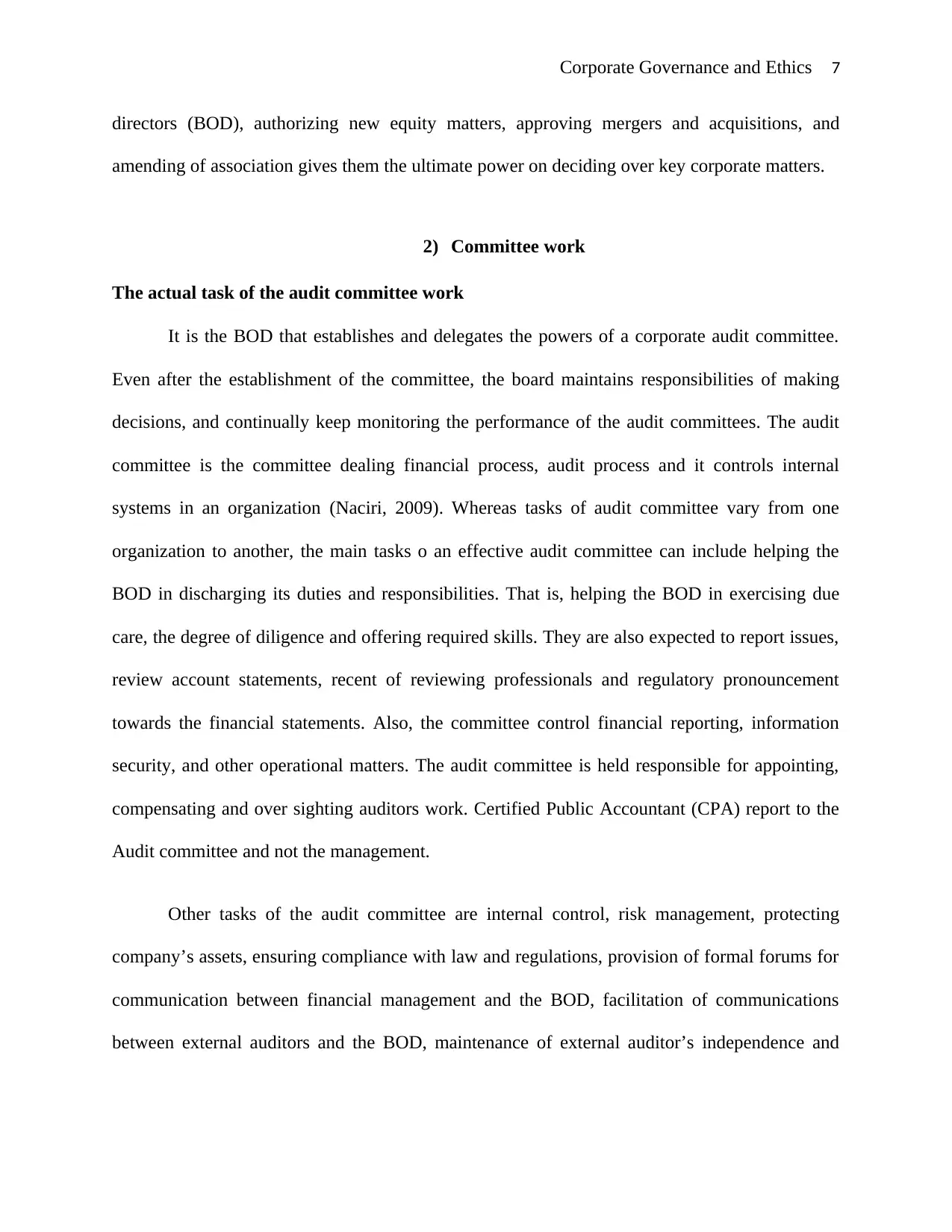
Corporate Governance and Ethics 7
directors (BOD), authorizing new equity matters, approving mergers and acquisitions, and
amending of association gives them the ultimate power on deciding over key corporate matters.
2) Committee work
The actual task of the audit committee work
It is the BOD that establishes and delegates the powers of a corporate audit committee.
Even after the establishment of the committee, the board maintains responsibilities of making
decisions, and continually keep monitoring the performance of the audit committees. The audit
committee is the committee dealing financial process, audit process and it controls internal
systems in an organization (Naciri, 2009). Whereas tasks of audit committee vary from one
organization to another, the main tasks o an effective audit committee can include helping the
BOD in discharging its duties and responsibilities. That is, helping the BOD in exercising due
care, the degree of diligence and offering required skills. They are also expected to report issues,
review account statements, recent of reviewing professionals and regulatory pronouncement
towards the financial statements. Also, the committee control financial reporting, information
security, and other operational matters. The audit committee is held responsible for appointing,
compensating and over sighting auditors work. Certified Public Accountant (CPA) report to the
Audit committee and not the management.
Other tasks of the audit committee are internal control, risk management, protecting
company’s assets, ensuring compliance with law and regulations, provision of formal forums for
communication between financial management and the BOD, facilitation of communications
between external auditors and the BOD, maintenance of external auditor’s independence and
directors (BOD), authorizing new equity matters, approving mergers and acquisitions, and
amending of association gives them the ultimate power on deciding over key corporate matters.
2) Committee work
The actual task of the audit committee work
It is the BOD that establishes and delegates the powers of a corporate audit committee.
Even after the establishment of the committee, the board maintains responsibilities of making
decisions, and continually keep monitoring the performance of the audit committees. The audit
committee is the committee dealing financial process, audit process and it controls internal
systems in an organization (Naciri, 2009). Whereas tasks of audit committee vary from one
organization to another, the main tasks o an effective audit committee can include helping the
BOD in discharging its duties and responsibilities. That is, helping the BOD in exercising due
care, the degree of diligence and offering required skills. They are also expected to report issues,
review account statements, recent of reviewing professionals and regulatory pronouncement
towards the financial statements. Also, the committee control financial reporting, information
security, and other operational matters. The audit committee is held responsible for appointing,
compensating and over sighting auditors work. Certified Public Accountant (CPA) report to the
Audit committee and not the management.
Other tasks of the audit committee are internal control, risk management, protecting
company’s assets, ensuring compliance with law and regulations, provision of formal forums for
communication between financial management and the BOD, facilitation of communications
between external auditors and the BOD, maintenance of external auditor’s independence and
Paraphrase This Document
Need a fresh take? Get an instant paraphrase of this document with our AI Paraphraser
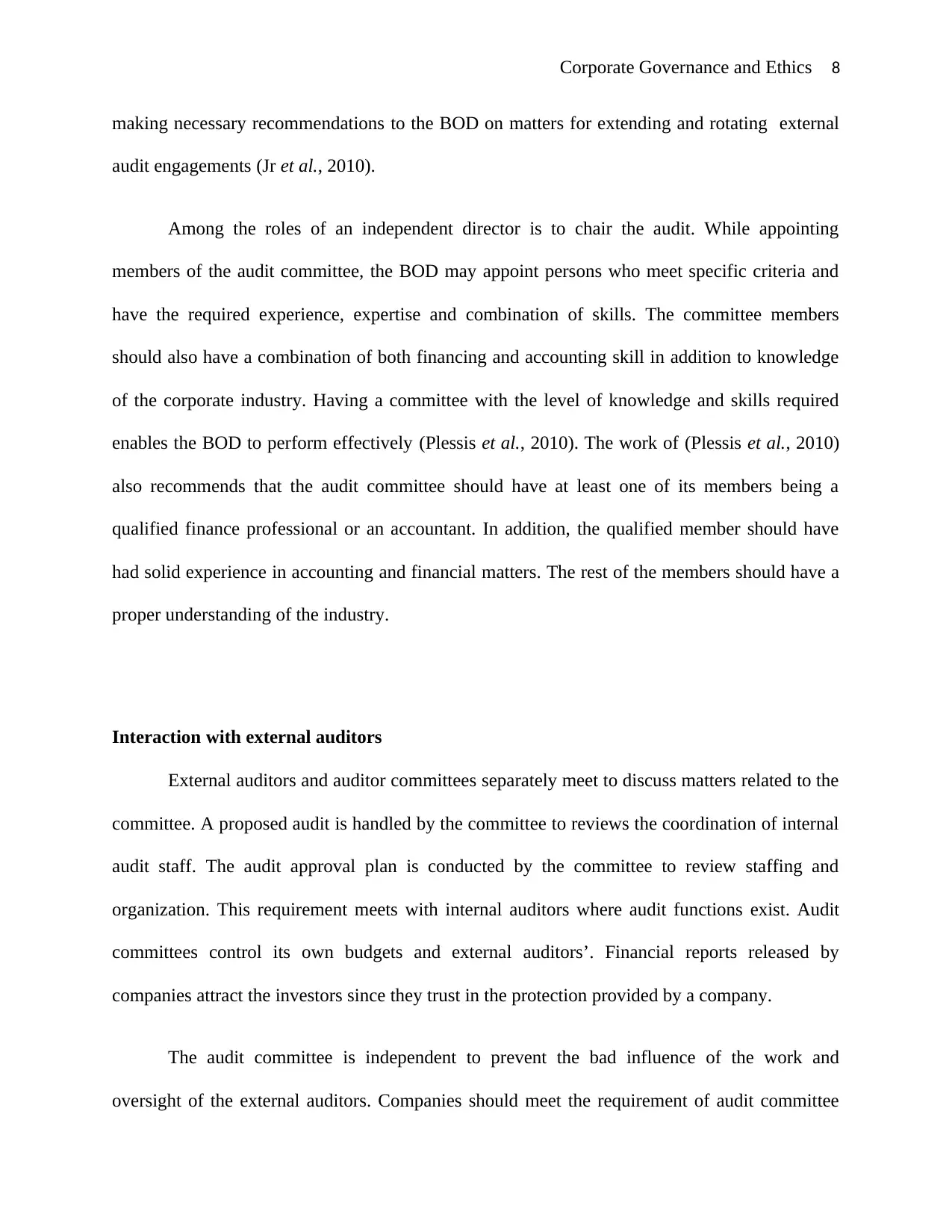
Corporate Governance and Ethics 8
making necessary recommendations to the BOD on matters for extending and rotating external
audit engagements (Jr et al., 2010).
Among the roles of an independent director is to chair the audit. While appointing
members of the audit committee, the BOD may appoint persons who meet specific criteria and
have the required experience, expertise and combination of skills. The committee members
should also have a combination of both financing and accounting skill in addition to knowledge
of the corporate industry. Having a committee with the level of knowledge and skills required
enables the BOD to perform effectively (Plessis et al., 2010). The work of (Plessis et al., 2010)
also recommends that the audit committee should have at least one of its members being a
qualified finance professional or an accountant. In addition, the qualified member should have
had solid experience in accounting and financial matters. The rest of the members should have a
proper understanding of the industry.
Interaction with external auditors
External auditors and auditor committees separately meet to discuss matters related to the
committee. A proposed audit is handled by the committee to reviews the coordination of internal
audit staff. The audit approval plan is conducted by the committee to review staffing and
organization. This requirement meets with internal auditors where audit functions exist. Audit
committees control its own budgets and external auditors’. Financial reports released by
companies attract the investors since they trust in the protection provided by a company.
The audit committee is independent to prevent the bad influence of the work and
oversight of the external auditors. Companies should meet the requirement of audit committee
making necessary recommendations to the BOD on matters for extending and rotating external
audit engagements (Jr et al., 2010).
Among the roles of an independent director is to chair the audit. While appointing
members of the audit committee, the BOD may appoint persons who meet specific criteria and
have the required experience, expertise and combination of skills. The committee members
should also have a combination of both financing and accounting skill in addition to knowledge
of the corporate industry. Having a committee with the level of knowledge and skills required
enables the BOD to perform effectively (Plessis et al., 2010). The work of (Plessis et al., 2010)
also recommends that the audit committee should have at least one of its members being a
qualified finance professional or an accountant. In addition, the qualified member should have
had solid experience in accounting and financial matters. The rest of the members should have a
proper understanding of the industry.
Interaction with external auditors
External auditors and auditor committees separately meet to discuss matters related to the
committee. A proposed audit is handled by the committee to reviews the coordination of internal
audit staff. The audit approval plan is conducted by the committee to review staffing and
organization. This requirement meets with internal auditors where audit functions exist. Audit
committees control its own budgets and external auditors’. Financial reports released by
companies attract the investors since they trust in the protection provided by a company.
The audit committee is independent to prevent the bad influence of the work and
oversight of the external auditors. Companies should meet the requirement of audit committee
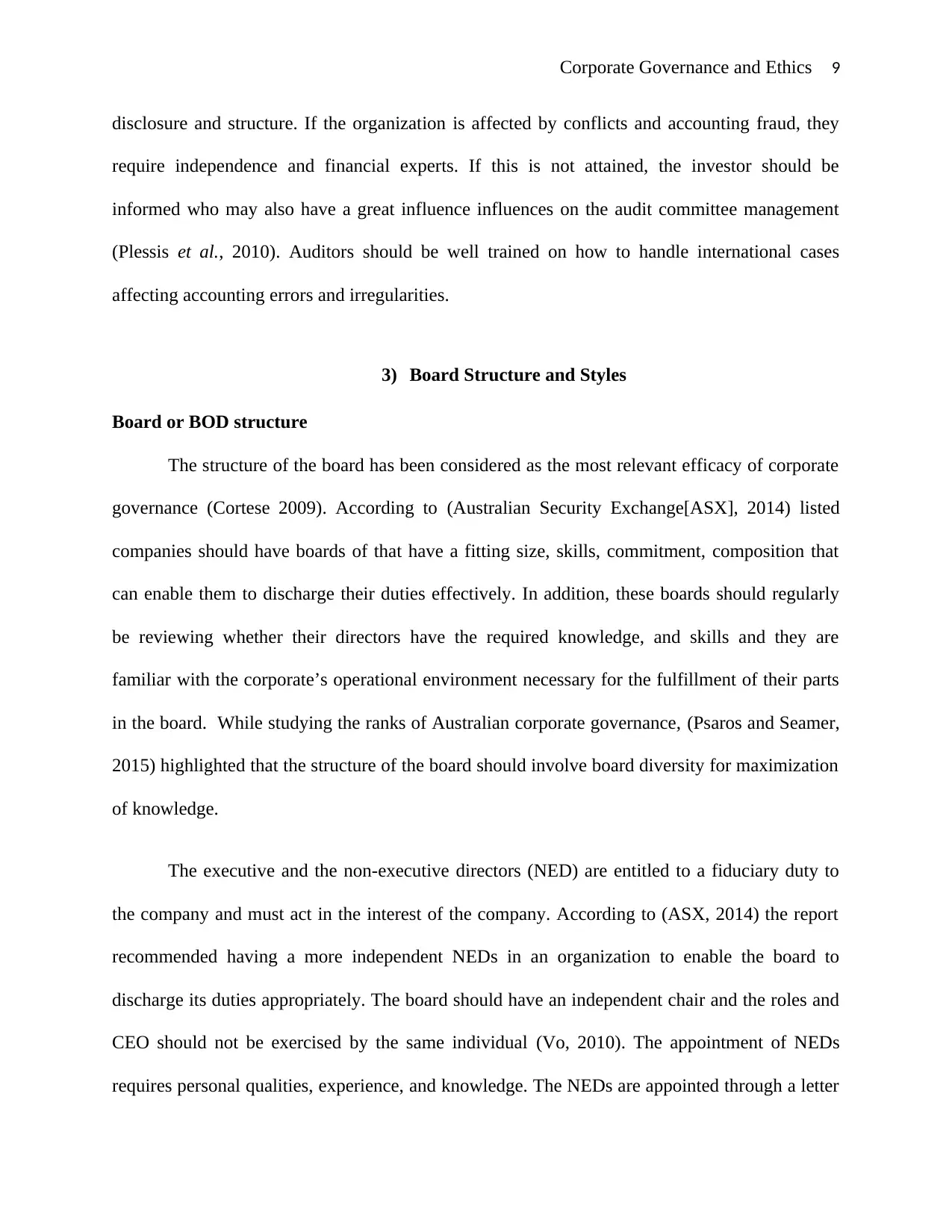
Corporate Governance and Ethics 9
disclosure and structure. If the organization is affected by conflicts and accounting fraud, they
require independence and financial experts. If this is not attained, the investor should be
informed who may also have a great influence influences on the audit committee management
(Plessis et al., 2010). Auditors should be well trained on how to handle international cases
affecting accounting errors and irregularities.
3) Board Structure and Styles
Board or BOD structure
The structure of the board has been considered as the most relevant efficacy of corporate
governance (Cortese 2009). According to (Australian Security Exchange[ASX], 2014) listed
companies should have boards of that have a fitting size, skills, commitment, composition that
can enable them to discharge their duties effectively. In addition, these boards should regularly
be reviewing whether their directors have the required knowledge, and skills and they are
familiar with the corporate’s operational environment necessary for the fulfillment of their parts
in the board. While studying the ranks of Australian corporate governance, (Psaros and Seamer,
2015) highlighted that the structure of the board should involve board diversity for maximization
of knowledge.
The executive and the non-executive directors (NED) are entitled to a fiduciary duty to
the company and must act in the interest of the company. According to (ASX, 2014) the report
recommended having a more independent NEDs in an organization to enable the board to
discharge its duties appropriately. The board should have an independent chair and the roles and
CEO should not be exercised by the same individual (Vo, 2010). The appointment of NEDs
requires personal qualities, experience, and knowledge. The NEDs are appointed through a letter
disclosure and structure. If the organization is affected by conflicts and accounting fraud, they
require independence and financial experts. If this is not attained, the investor should be
informed who may also have a great influence influences on the audit committee management
(Plessis et al., 2010). Auditors should be well trained on how to handle international cases
affecting accounting errors and irregularities.
3) Board Structure and Styles
Board or BOD structure
The structure of the board has been considered as the most relevant efficacy of corporate
governance (Cortese 2009). According to (Australian Security Exchange[ASX], 2014) listed
companies should have boards of that have a fitting size, skills, commitment, composition that
can enable them to discharge their duties effectively. In addition, these boards should regularly
be reviewing whether their directors have the required knowledge, and skills and they are
familiar with the corporate’s operational environment necessary for the fulfillment of their parts
in the board. While studying the ranks of Australian corporate governance, (Psaros and Seamer,
2015) highlighted that the structure of the board should involve board diversity for maximization
of knowledge.
The executive and the non-executive directors (NED) are entitled to a fiduciary duty to
the company and must act in the interest of the company. According to (ASX, 2014) the report
recommended having a more independent NEDs in an organization to enable the board to
discharge its duties appropriately. The board should have an independent chair and the roles and
CEO should not be exercised by the same individual (Vo, 2010). The appointment of NEDs
requires personal qualities, experience, and knowledge. The NEDs are appointed through a letter
⊘ This is a preview!⊘
Do you want full access?
Subscribe today to unlock all pages.

Trusted by 1+ million students worldwide
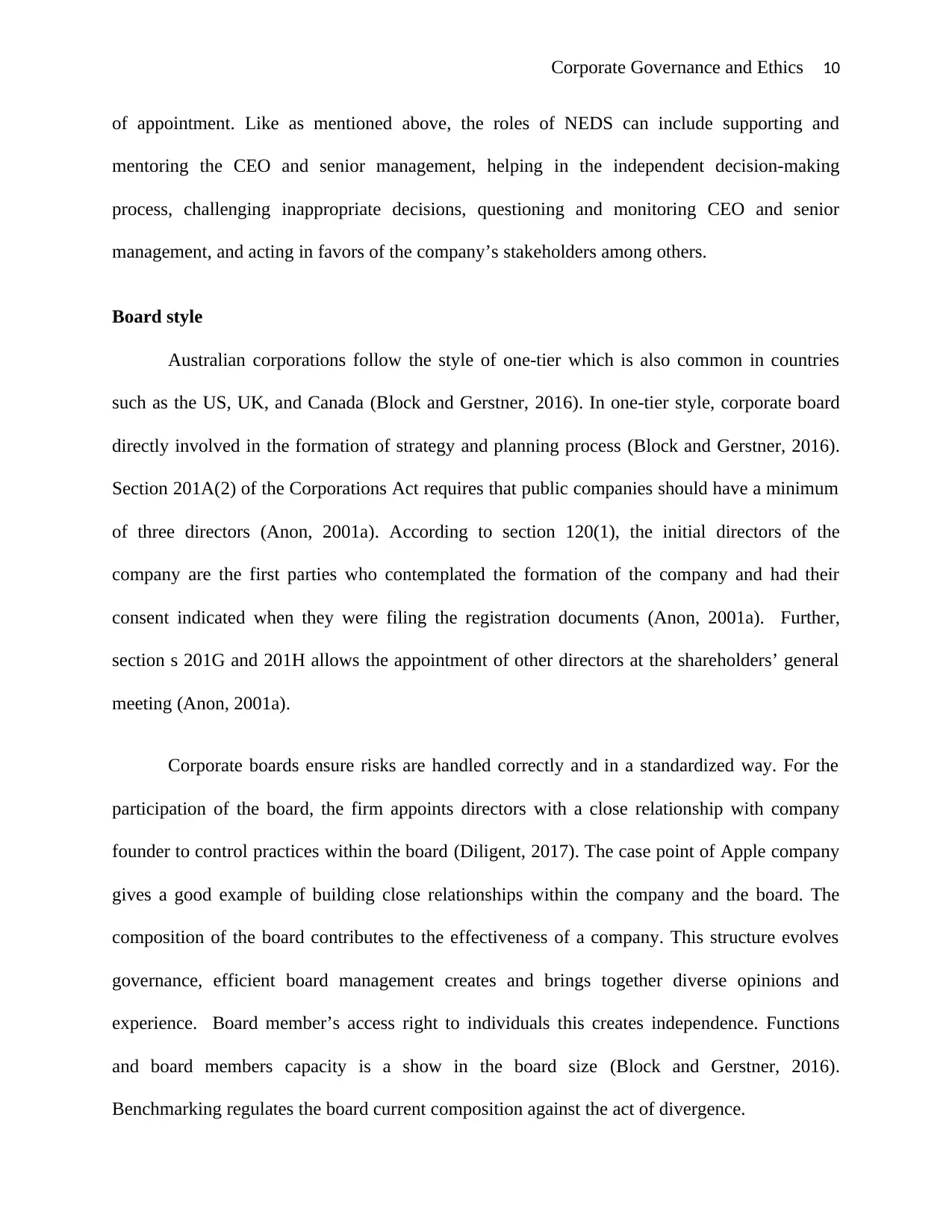
Corporate Governance and Ethics 10
of appointment. Like as mentioned above, the roles of NEDS can include supporting and
mentoring the CEO and senior management, helping in the independent decision-making
process, challenging inappropriate decisions, questioning and monitoring CEO and senior
management, and acting in favors of the company’s stakeholders among others.
Board style
Australian corporations follow the style of one-tier which is also common in countries
such as the US, UK, and Canada (Block and Gerstner, 2016). In one-tier style, corporate board
directly involved in the formation of strategy and planning process (Block and Gerstner, 2016).
Section 201A(2) of the Corporations Act requires that public companies should have a minimum
of three directors (Anon, 2001a). According to section 120(1), the initial directors of the
company are the first parties who contemplated the formation of the company and had their
consent indicated when they were filing the registration documents (Anon, 2001a). Further,
section s 201G and 201H allows the appointment of other directors at the shareholders’ general
meeting (Anon, 2001a).
Corporate boards ensure risks are handled correctly and in a standardized way. For the
participation of the board, the firm appoints directors with a close relationship with company
founder to control practices within the board (Diligent, 2017). The case point of Apple company
gives a good example of building close relationships within the company and the board. The
composition of the board contributes to the effectiveness of a company. This structure evolves
governance, efficient board management creates and brings together diverse opinions and
experience. Board member’s access right to individuals this creates independence. Functions
and board members capacity is a show in the board size (Block and Gerstner, 2016).
Benchmarking regulates the board current composition against the act of divergence.
of appointment. Like as mentioned above, the roles of NEDS can include supporting and
mentoring the CEO and senior management, helping in the independent decision-making
process, challenging inappropriate decisions, questioning and monitoring CEO and senior
management, and acting in favors of the company’s stakeholders among others.
Board style
Australian corporations follow the style of one-tier which is also common in countries
such as the US, UK, and Canada (Block and Gerstner, 2016). In one-tier style, corporate board
directly involved in the formation of strategy and planning process (Block and Gerstner, 2016).
Section 201A(2) of the Corporations Act requires that public companies should have a minimum
of three directors (Anon, 2001a). According to section 120(1), the initial directors of the
company are the first parties who contemplated the formation of the company and had their
consent indicated when they were filing the registration documents (Anon, 2001a). Further,
section s 201G and 201H allows the appointment of other directors at the shareholders’ general
meeting (Anon, 2001a).
Corporate boards ensure risks are handled correctly and in a standardized way. For the
participation of the board, the firm appoints directors with a close relationship with company
founder to control practices within the board (Diligent, 2017). The case point of Apple company
gives a good example of building close relationships within the company and the board. The
composition of the board contributes to the effectiveness of a company. This structure evolves
governance, efficient board management creates and brings together diverse opinions and
experience. Board member’s access right to individuals this creates independence. Functions
and board members capacity is a show in the board size (Block and Gerstner, 2016).
Benchmarking regulates the board current composition against the act of divergence.
Paraphrase This Document
Need a fresh take? Get an instant paraphrase of this document with our AI Paraphraser
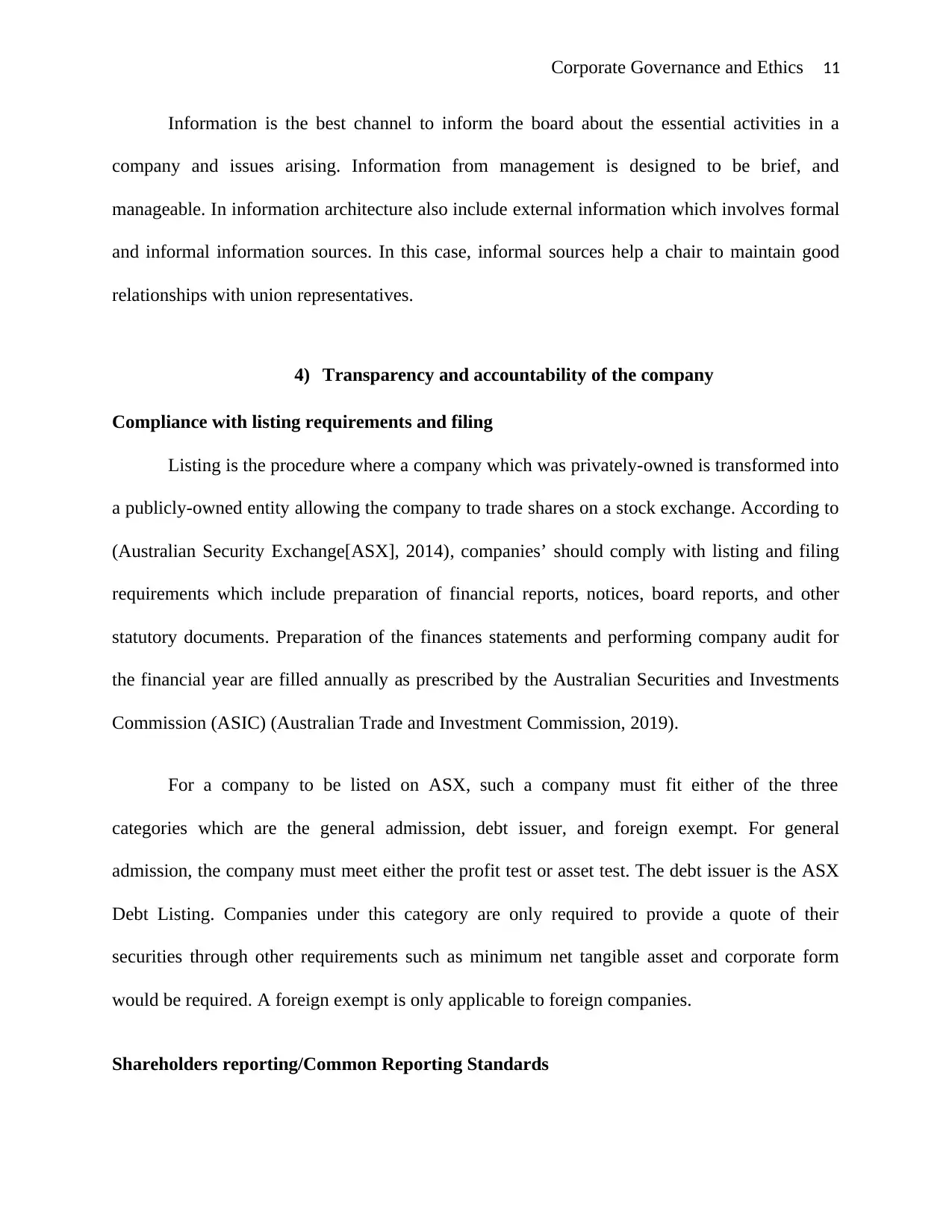
Corporate Governance and Ethics 11
Information is the best channel to inform the board about the essential activities in a
company and issues arising. Information from management is designed to be brief, and
manageable. In information architecture also include external information which involves formal
and informal information sources. In this case, informal sources help a chair to maintain good
relationships with union representatives.
4) Transparency and accountability of the company
Compliance with listing requirements and filing
Listing is the procedure where a company which was privately-owned is transformed into
a publicly-owned entity allowing the company to trade shares on a stock exchange. According to
(Australian Security Exchange[ASX], 2014), companies’ should comply with listing and filing
requirements which include preparation of financial reports, notices, board reports, and other
statutory documents. Preparation of the finances statements and performing company audit for
the financial year are filled annually as prescribed by the Australian Securities and Investments
Commission (ASIC) (Australian Trade and Investment Commission, 2019).
For a company to be listed on ASX, such a company must fit either of the three
categories which are the general admission, debt issuer, and foreign exempt. For general
admission, the company must meet either the profit test or asset test. The debt issuer is the ASX
Debt Listing. Companies under this category are only required to provide a quote of their
securities through other requirements such as minimum net tangible asset and corporate form
would be required. A foreign exempt is only applicable to foreign companies.
Shareholders reporting/Common Reporting Standards
Information is the best channel to inform the board about the essential activities in a
company and issues arising. Information from management is designed to be brief, and
manageable. In information architecture also include external information which involves formal
and informal information sources. In this case, informal sources help a chair to maintain good
relationships with union representatives.
4) Transparency and accountability of the company
Compliance with listing requirements and filing
Listing is the procedure where a company which was privately-owned is transformed into
a publicly-owned entity allowing the company to trade shares on a stock exchange. According to
(Australian Security Exchange[ASX], 2014), companies’ should comply with listing and filing
requirements which include preparation of financial reports, notices, board reports, and other
statutory documents. Preparation of the finances statements and performing company audit for
the financial year are filled annually as prescribed by the Australian Securities and Investments
Commission (ASIC) (Australian Trade and Investment Commission, 2019).
For a company to be listed on ASX, such a company must fit either of the three
categories which are the general admission, debt issuer, and foreign exempt. For general
admission, the company must meet either the profit test or asset test. The debt issuer is the ASX
Debt Listing. Companies under this category are only required to provide a quote of their
securities through other requirements such as minimum net tangible asset and corporate form
would be required. A foreign exempt is only applicable to foreign companies.
Shareholders reporting/Common Reporting Standards
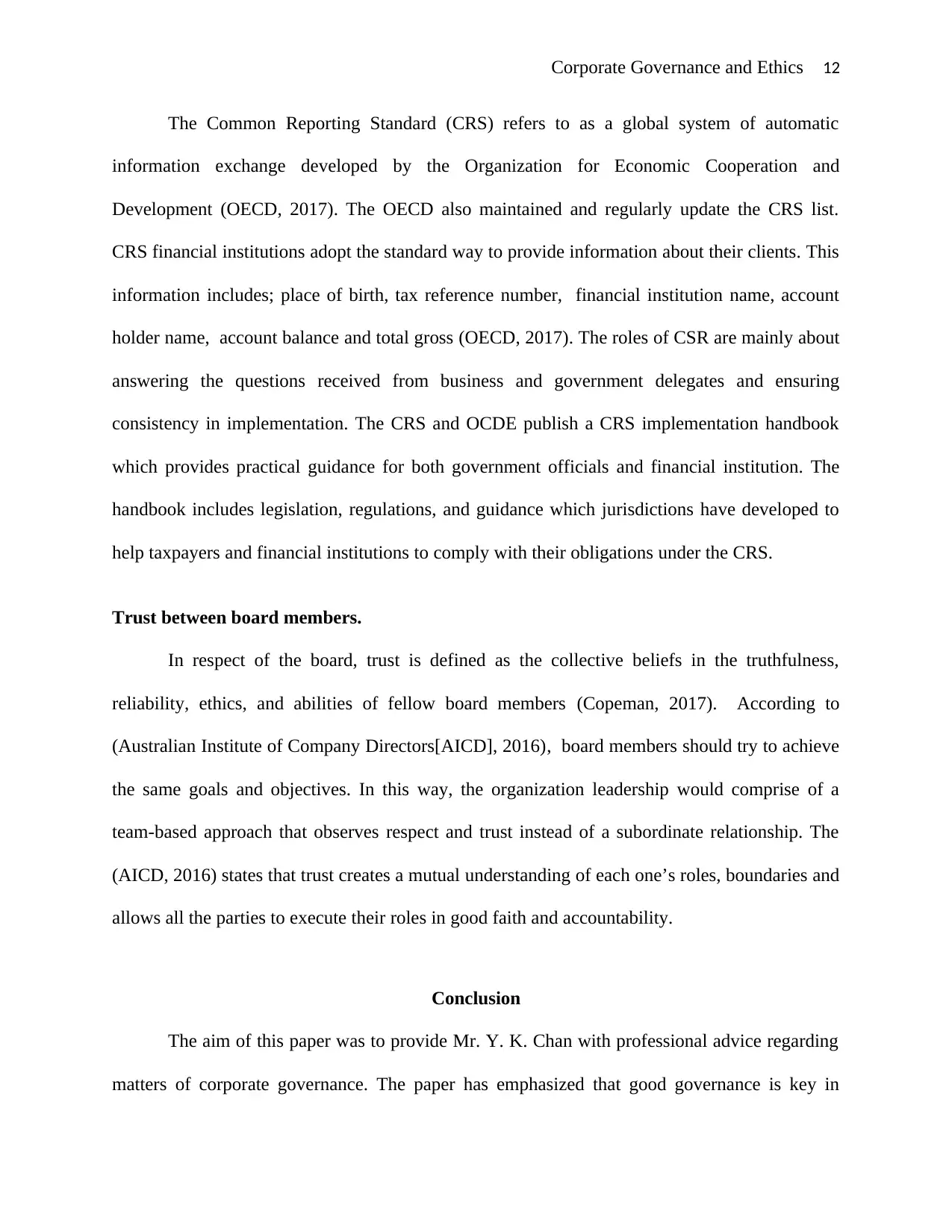
Corporate Governance and Ethics 12
The Common Reporting Standard (CRS) refers to as a global system of automatic
information exchange developed by the Organization for Economic Cooperation and
Development (OECD, 2017). The OECD also maintained and regularly update the CRS list.
CRS financial institutions adopt the standard way to provide information about their clients. This
information includes; place of birth, tax reference number, financial institution name, account
holder name, account balance and total gross (OECD, 2017). The roles of CSR are mainly about
answering the questions received from business and government delegates and ensuring
consistency in implementation. The CRS and OCDE publish a CRS implementation handbook
which provides practical guidance for both government officials and financial institution. The
handbook includes legislation, regulations, and guidance which jurisdictions have developed to
help taxpayers and financial institutions to comply with their obligations under the CRS.
Trust between board members.
In respect of the board, trust is defined as the collective beliefs in the truthfulness,
reliability, ethics, and abilities of fellow board members (Copeman, 2017). According to
(Australian Institute of Company Directors[AICD], 2016), board members should try to achieve
the same goals and objectives. In this way, the organization leadership would comprise of a
team-based approach that observes respect and trust instead of a subordinate relationship. The
(AICD, 2016) states that trust creates a mutual understanding of each one’s roles, boundaries and
allows all the parties to execute their roles in good faith and accountability.
Conclusion
The aim of this paper was to provide Mr. Y. K. Chan with professional advice regarding
matters of corporate governance. The paper has emphasized that good governance is key in
The Common Reporting Standard (CRS) refers to as a global system of automatic
information exchange developed by the Organization for Economic Cooperation and
Development (OECD, 2017). The OECD also maintained and regularly update the CRS list.
CRS financial institutions adopt the standard way to provide information about their clients. This
information includes; place of birth, tax reference number, financial institution name, account
holder name, account balance and total gross (OECD, 2017). The roles of CSR are mainly about
answering the questions received from business and government delegates and ensuring
consistency in implementation. The CRS and OCDE publish a CRS implementation handbook
which provides practical guidance for both government officials and financial institution. The
handbook includes legislation, regulations, and guidance which jurisdictions have developed to
help taxpayers and financial institutions to comply with their obligations under the CRS.
Trust between board members.
In respect of the board, trust is defined as the collective beliefs in the truthfulness,
reliability, ethics, and abilities of fellow board members (Copeman, 2017). According to
(Australian Institute of Company Directors[AICD], 2016), board members should try to achieve
the same goals and objectives. In this way, the organization leadership would comprise of a
team-based approach that observes respect and trust instead of a subordinate relationship. The
(AICD, 2016) states that trust creates a mutual understanding of each one’s roles, boundaries and
allows all the parties to execute their roles in good faith and accountability.
Conclusion
The aim of this paper was to provide Mr. Y. K. Chan with professional advice regarding
matters of corporate governance. The paper has emphasized that good governance is key in
⊘ This is a preview!⊘
Do you want full access?
Subscribe today to unlock all pages.

Trusted by 1+ million students worldwide
1 out of 15
Related Documents
Your All-in-One AI-Powered Toolkit for Academic Success.
+13062052269
info@desklib.com
Available 24*7 on WhatsApp / Email
![[object Object]](/_next/static/media/star-bottom.7253800d.svg)
Unlock your academic potential
Copyright © 2020–2025 A2Z Services. All Rights Reserved. Developed and managed by ZUCOL.




